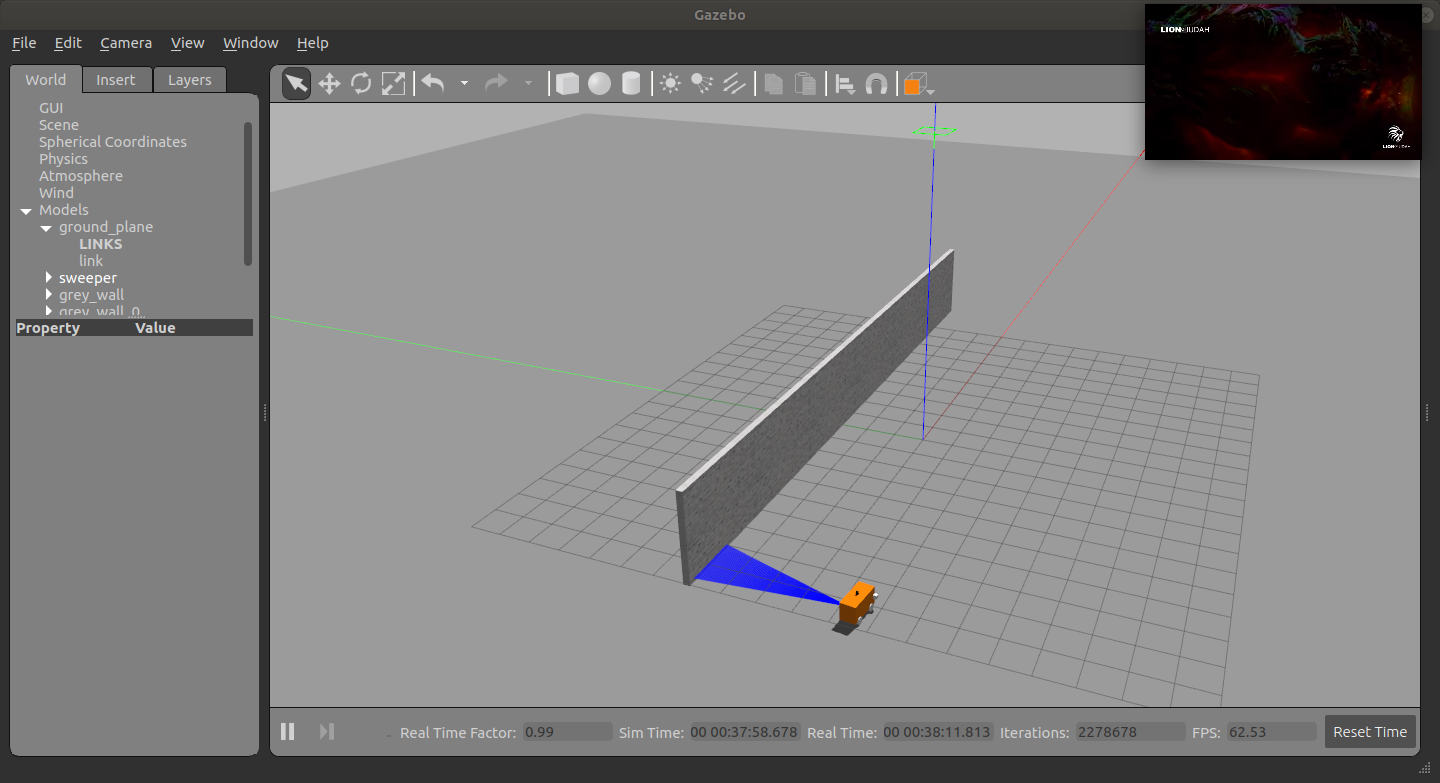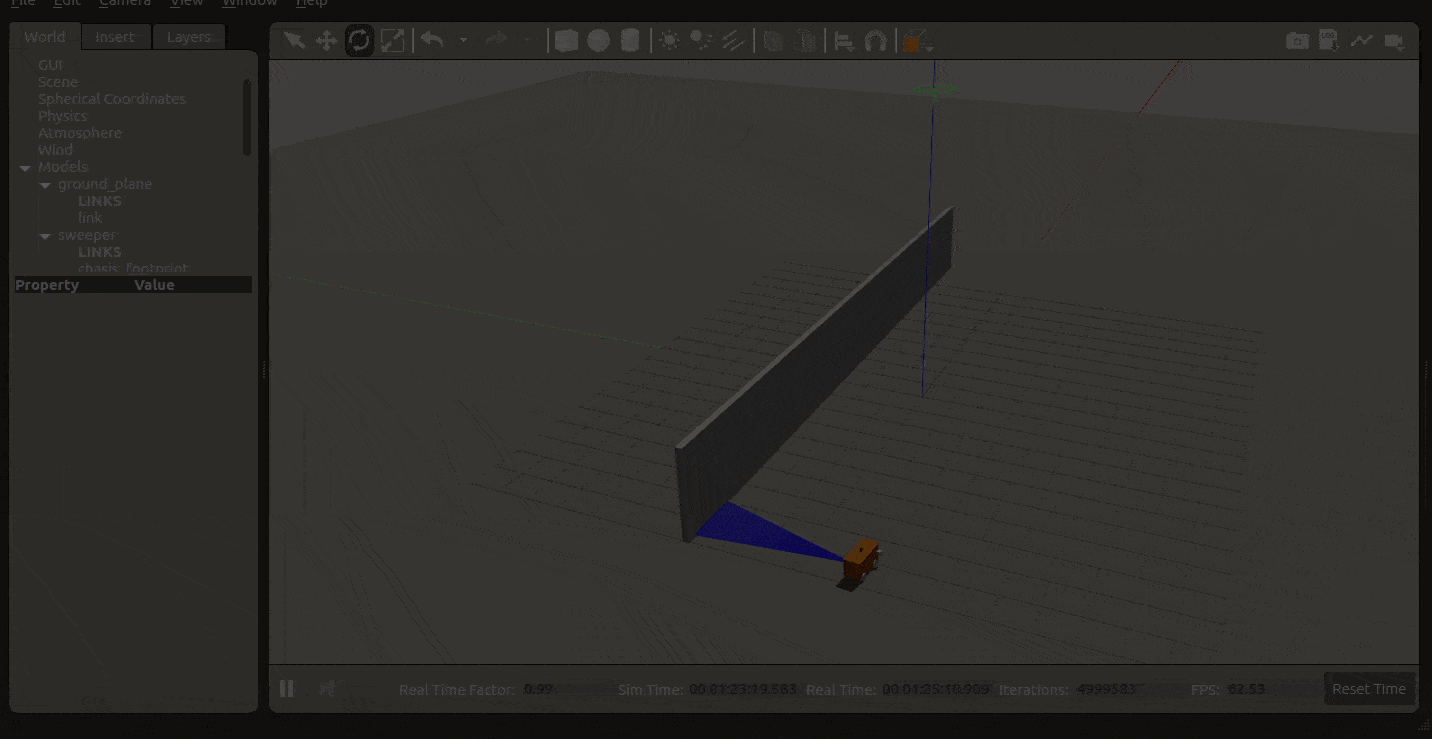Implementing PID to follow wall
My problem is 2-fold.
1 :
I am using move_base and successfully getting my robot model to autonomously navigate from one pose to another in a gazebo world. However, I am looking for a way to finetune the robots' path. Specifically, I want the model to travel close to the left or right wall, depending on which side I specify, maintaining a consistent predefined gap between the wall and robot.
I minimised my gazebo world to the following :

The laser currently has a distnce of 194.374211311 between the wall and the left side of the robot. I need the robot to travel alongside the wall with a seperating distance of 25. I tried accomplishing this with the following code :
#!/usr/bin/env python
import rospy
import math
from sensor_msgs.msg import LaserScan
from geometry_msgs.msg import Twist
import sys
class WallTracker :
data_left = 0
cdm_vel_publisher = ''
def __init__(self):
rospy.init_node('laser_ranging', anonymous=False)
self.cdm_vel_publisher = rospy.Publisher('/cmd_vel', Twist, queue_size=10)
rospy.Subscriber('scan_left', LaserScan, self.sample)
rospy.Subscriber("cmd_vel_original", Twist, self.move)
rospy.spin()
def sample(self, data):
cleanedData = filter(lambda x: not math.isinf(x), data.ranges)
self.data_left = sum(cleanedData)
def move(self, twist):
rospy.loginfo('RANGING LEFT : ' + str(self.data_left))
rospy.loginfo(twist)
new_twist = Twist()
new_twist = twist
rospy.loginfo(new_twist)
limit = 20
# Also tried ...
new_twist.linear.x = twist.linear.x
new_twist.linear.y = twist.linear.y
new_twist.linear.z = twist.linear.z
new_twist.angular.x = twist.angular.x
new_twist.angular.y = twist.angular.y
# new_twist.angular.z = twist.angular.z
if(self.data_left > limit):
new_twist.angular.z = 1
rospy.loginfo('Data-Left['+str(self.data_left)+'] > ' + str(limit))
else:
new_twist.angular.z = 0
rospy.loginfo('Data-Left['+str(self.data_left)+'] < ' + str(limit))
self.cdm_vel_publisher.publish(new_twist)
if __name__ == "__main__":
WallTracker()
I am basically trying to amend the angular.z value of the twist from cmd_vel. The idea is to allow the robot to continue it's movement while turning it to the left and bringing it closer to the wall.
BUT, I find the robot only turns in place.

From the terminal output, it seems my attempt to duplicate the twist data as generated by move_base has failed and only my angular.z data is in my newly created and published twist data.
Echoing out the cmd_vel topic bears me out. When I commentout the entire if-statement, I have linear.x data coming from move_base. But with the if-statement that linear.x value is absent.
2 :
How can I implement a PID to get the robot model to accurately drive alongside the wall ?


Are you updating
data_left? If it's always spinning then it seems to be always greater thanlimit. Is this the entirety of the code that you're using? If not, please update your question with all of the code that you're using@jayess:
data_leftis the total of all the numbers on thescan_lefttopic having removed all inf occurances. The closer the robot moves towards the wall, the smaller data_left becomes.The twist messages in the GIF seem to be constant and have
angular.z = 1--even at the end, when the robot stops turning. It seems that value isn't coming from your code. Do you know what's generating it?On a side note, you should probably not create the
Publisher()inmove()if you're calling it often. Usually, one would create thePublisher()as a member of a class when initializing the node. Then other class methods can publish as needed.@tryan: Thanks. I refactored my code into a class so the publisher object is created as the instance of my class is being initiated. As for the
angular.z=1issue, I noticed it but I honestly don't know where it coming from. It does seem to be coming from the same code however. If I commen out my if-statement and the preceeding twist assignement code, I don't get angular.z = 1Run
to see what other nodes are publishing to that topic
@jayess: Only my node is publishing to
cmd_vel. This is VERY strange because the else section of my if statement should be settingangular.zto 0. But I am now getting -1 or 1 as observered by @tryan.I see now.
rospy.loginfo(new_twist)is printingnew_twist = twistbefore you modify it, so it seems that's just the value coming from/cmd_vel. You can echo/cmd_veldirectly to confirm. If that is the case, then there's no non-zero components besidesangular.z, so I would expect your robot to spin like it's doing. Further, in the GIF, the robot does stop when the limit is reached, so it's probably getting the correct message (angular.z = 0). All that's left then is to figure out why/cmd_velisn't what you think it should be.